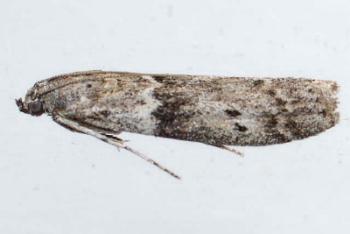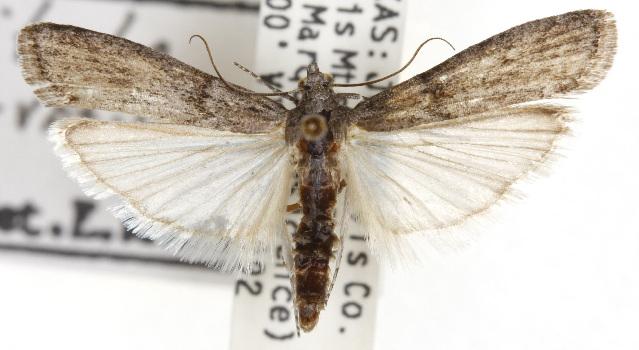
| Mill Moth (one synonym : Homoeosoma ischnomorpha Meyrick, 1931) PHYCITINI, PHYCITINAE, PYRALIDAE, PYRALOIDEA | (donherbisonevans@yahoo.com) and Stella Crossley |

(Picture: courtesy of Servicio Nacional de Sanidad Agraria del Peru)

| Mill Moth (one synonym : Homoeosoma ischnomorpha Meyrick, 1931) PHYCITINI, PHYCITINAE, PYRALIDAE, PYRALOIDEA | (donherbisonevans@yahoo.com) and Stella Crossley |

(Picture: courtesy of Servicio Nacional de Sanidad Agraria del Peru)
This Caterpillar is a worldwide pest, particularly of
The caterpillar is off-white with a brown head and collar. The caterpillar grows to a length of about 1 cm.
When one caterpillar encounters another, they each produce a small amount of brown liquid from the mouth containing kairomones that cause the caterpillars to walk apart. This appears to be a mechanism that prevents overcrowding of the caterpillars. The secretion also deters female moths from laying eggs in that vicinty. Unfortunately for the caterpillars, this mandibular secretion also attracts parasitoid wasps such as Venturia canescens.

The moths are fawn coloured, with variable vague spotty dark bars across each forewing. The hindwings are plain off-white, shading to brown on the margins. The adult moths have a wingspan of about 2 cms. The adults use ultrasonic sounds (~80 Khz) in their courtship behaviour.

The species occurs world-wide, for example
The species was introduced into Australia by unfortunate accident. It is now found, for example, in
Various strategies have been suggested to control it, for example :
Further reading :
Ian F.B. Common,
Moths of Australia,
Melbourne University Press, 1990, pp. 48, 350.
Philipp C. Zeller,
Lepidopterologische Bemerkungen,
Entomologische Zeitung, Stettin,
Volume 40, Parts 10-12 (1879), pp. 466-471, No. 3.
 caterpillar |  butterflies |  Lepidoptera |  moths |  caterpillar |
(updated 30 January 2010, 27 August 2020, 21 April 2022)